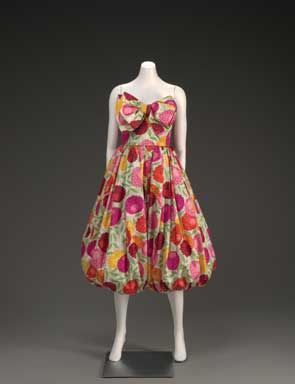'Fashion in Bloom' @ the Indianapolis Museum of Art
Norman Norell for Traina–Norell, American, b. Noblesville, Indiana, 1900–1972, evening dress, 1959, silk taffeta, Gift of Jocelyn S. Schwartzman and Stanley E. Weaver in memory of Norman Norell.
INDIANAPOLIS, IN.- This spring, the gardens and grounds aren’t the only thing in bloom at the Indianapolis Museum of Art. Today, April 4, 2009, the Museum will open Fashion in Bloom in the Paul Fashion Arts Gallery. The exhibition will run through January 31, 2010.
Featuring 24 garments from the IMA’s permanent collection, Fashion in Bloom traces the use of floral motifs in European and American fashions from the 18th to the 20th centuries, as well as the various methods used to execute floral patterns on garments, including printing, embroidery, beading and brocading. Among the designers whose work will be exhibited are Norman Norell, Bill Blass, Givenchy, Galanos, Trigère and Callot Soeurs. The exhibition is free to the public and is open during Museum hours.
While flowers are the exhibition’s theme, women’s clothing styles are its emphasis. Fashion in Bloom offers an in-depth look at the major styles of Western fashion by providing a framework of significant shifts in silhouettes of feminine attire from the late 1700s to 1970s.
“As clothing styles have changed, flowers remain a source of inspiration to apparel designers,” said Niloo Paydar, curator of textile & fashion arts at the IMA. “The floral motif is ancient yet timeless, and has been used in many cultures. The garments in this exhibition, all from the IMA collection, demonstrate the many applications of this popular motif in European and American fashion throughout the past two centuries.”
The exhibition explores the many ways women’s bodies have been manipulated, disguised or exploited by fashion designers, from the age of corsets and layers of crinolines to the era of short hemlines and curve-hugging fabrics. It includes examples of fashions ranging from elaborate ball gowns to simple day dresses. To help visitors understand the challenges inherent in women’s wear of the past, scaled-down versions of the dress styles are displayed in The Dorothy and Lee Alig Textile Learning Center, allowing hands-on inspection.
By comparison, the show includes one example of men’s wear—a French suit from 1775. While more elaborate in cut and decoration than its contemporary counterparts, it remains the basic men’s ensemble of a jacket, vest and pants, demonstrating how little men’s fashion has changed in the time period covered by the exhibition.
26-acre estate's landscape was designed in the 1920s by Percival Gallagher of the famous Olmsted Brothers firm. Features of Oldfields include: the colorful, seasonal displays of the Formal Garden; the flowering shrubs, wildflowers and streams of the Ravine Garden; a tree-lined Allée leading up to Lilly House; and unusual combinations of bulbs, perennials, annuals, shrubs and trees in the Border Gardens. Group tours may be scheduled by contacting the IMA Tourism Coordinator at least three weeks in advance at 317-920-2679 or e-mailing grouptours@imamuseum.org.
Hanae Mori, Japanese, b. 1926, dress, 1970s, silk velvet

/https%3A%2F%2Fprofilepics.canalblog.com%2Fprofilepics%2F1%2F0%2F100183.jpg)
/https%3A%2F%2Fstorage.canalblog.com%2F03%2F02%2F119589%2F96711876_o.jpg)
/https%3A%2F%2Fstorage.canalblog.com%2F11%2F31%2F119589%2F94773502_o.jpg)
/https%3A%2F%2Fstorage.canalblog.com%2F20%2F83%2F119589%2F94772815_o.jpg)
/https%3A%2F%2Fstorage.canalblog.com%2F26%2F72%2F119589%2F75604929_o.jpg)
/https%3A%2F%2Fstorage.canalblog.com%2F59%2F60%2F119589%2F26458628_o.jpg)




/http%3A%2F%2Fstorage.canalblog.com%2F23%2F24%2F119589%2F107474641_o.jpg)
/http%3A%2F%2Fstorage.canalblog.com%2F71%2F54%2F119589%2F95959823_o.jpg)
/http%3A%2F%2Fstorage.canalblog.com%2F59%2F47%2F119589%2F72354679_o.jpg)
/http%3A%2F%2Fstorage.canalblog.com%2F43%2F63%2F119589%2F35079513_o.jpg)